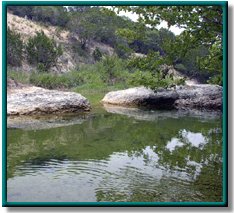Rocky Creek and Salado Creek
Counties: Bell, Burnet, Williamson
Parameter: Dissolved oxygen
Basin: Brazos River
Segments: 1217A, 1243
On this page:
- Project Background and Goals
- Watershed Description
- Public Participation
- Status
- Contact the TMDL Program
Project Background and Goals
In Rocky Creek and Salado Creek in the middle Brazos River Basin, water quality testing indicated that low dissolved oxygen levels were not optimal for supporting a healthy aquatic community.
Oxygen gas, which dissolves in water, is essential for the survival of aquatic life. While the amount of dissolved oxygen in water fluctuates naturally, various human activities can cause unusually or chronically low dissolved oxygen levels, which may harm fish and other aquatic organisms.
In response to these conditions, the Total Maximum Daily Load (TMDL) Team initiated a project to investigate the causes of low dissolved oxygen in the creeks, with the goal of determining whether the creeks could support a healthy aquatic community.
Project staff evaluated the sources of oxygen-demanding materials and their impacts on dissolved oxygen in the two creeks. The purpose of the project was to determine the best strategy for managing water quality in the creeks.
Watershed Description
These two streams are located in south-central Texas in the Brazos River Basin. Rocky Creek begins at the confluence of North Rocky and South Rocky Creeks and flows east into the Lampasas River, north of Oakalla. Only the lower 4 miles of this 12-mile stream did not meet the dissolved oxygen criteria associated with the aquatic life use.
Salado Creek begins at the confluence of North Salado and South Salado Creeks and flows east, approximately 27 miles, to the Lampasas River. The 10 mile-long portion examined in this study begins at Salado Creek’s confluence with the Lampasas River and extends upstream to the FM 2268 bridge in Salado (just east of Interstate 35).
Salado Creek has the larger watershed at 170 square miles, followed by Rocky Creek at 114 square miles. The watersheds are wholly or partially located in the Edwards Plateau physiographic province and the Oak Woods and Prairies natural region. The Rocky Creek watershed includes portions of Burnet County and the cities of Sunnylane, Watson, and Oakalla. The Salado Creek watershed includes portions of Bell and Williamson counties along with the cities of Florence, Corn Hill, Prairie Dell, Salado, and Sommers Mill.
Urban development is greatest in the Salado Creek watershed. About 98% of the land in the Rocky Creek watershed was privately owned at the time of this study. The major land use was cattle ranching. In general, the streams were used for agricultural purposes, recreation, and other activities, depending on time of year and streamflow. Rocky Creek was classified as an ecologically unique stream by the Texas Parks and Wildlife Department (TPWD) because of its unique geology and other characteristics.
Public Participation
To involve stakeholders in this project, the TCEQ worked with an existing forum—the Brazos River Authority Steering Committee, which was established under the Texas Clean Rivers Program. The steering committee includes representatives from state and federal agencies, cities, industries, citizen groups, local governments, universities, water districts, agriculture groups, and other water user groups.
Status
All dissolved oxygen measurements taken in Salado Creek were in compliance with the water quality standards. All measurements in Rocky Creek were in compliance with the water quality standards, with the exception of one station on the North Fork Rocky Creek.
Biological data collected subsequently from the North Fork of Rocky Creek indicate that the creek supports a relatively healthy biological community, better than would be expected based upon the results of the dissolved oxygen monitoring.
Salado and Rocky creeks were removed from the state’s 303(d) list of impaired waters in 2006. In 2010, TCEQ adopted revised, site-specific standards for dissolved oxygen in Rocky and Salado creeks. EPA approved those revisions.
Contact the TMDL Program
Please email tmdl@tceq.texas.gov and mention the Middle Brazos River project in the subject line. Or call us at 512-239-6682.





 Back to top
Back to top